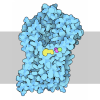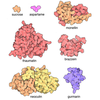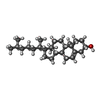+ Open data
Open data
- Basic information
Basic information
| Entry | Database: PDB / ID: 9p4z | ||||||
|---|---|---|---|---|---|---|---|
| Title | Human EAAT3 with sodium bound at inward facing state | ||||||
 Components Components | Excitatory amino acid transporter 3 | ||||||
 Keywords Keywords | TRANSPORT PROTEIN / hEAAAT3 / Sodium bound | ||||||
| Function / homology |  Function and homology information Function and homology informationD-aspartate transmembrane transport / regulation of protein targeting to membrane / D-aspartate transmembrane transporter activity / Defective SLC1A1 is implicated in schizophrenia 18 (SCZD18) and dicarboxylic aminoaciduria (DCBXA) / distal dendrite / cysteine transport / cysteine transmembrane transporter activity / neurotransmitter receptor transport to plasma membrane / high-affinity L-glutamate transmembrane transporter activity / glutamate:sodium symporter activity ...D-aspartate transmembrane transport / regulation of protein targeting to membrane / D-aspartate transmembrane transporter activity / Defective SLC1A1 is implicated in schizophrenia 18 (SCZD18) and dicarboxylic aminoaciduria (DCBXA) / distal dendrite / cysteine transport / cysteine transmembrane transporter activity / neurotransmitter receptor transport to plasma membrane / high-affinity L-glutamate transmembrane transporter activity / glutamate:sodium symporter activity / L-glutamate import / response to decreased oxygen levels / cellular response to mercury ion / : / L-glutamate transmembrane transporter activity / retina layer formation / L-glutamate transmembrane transport / glutathione biosynthetic process / D-aspartate import across plasma membrane / L-aspartate transmembrane transport / cellular response to ammonium ion / righting reflex / zinc ion transmembrane transport / L-aspartate transmembrane transporter activity / cellular response to bisphenol A / intracellular glutamate homeostasis / grooming behavior / L-aspartate import across plasma membrane / Glutamate Neurotransmitter Release Cycle / monoatomic anion channel activity / L-glutamate import across plasma membrane / proximal dendrite / transepithelial transport / apical dendrite / intracellular zinc ion homeostasis / blood vessel morphogenesis / cellular response to cocaine / chloride transmembrane transporter activity / motor neuron apoptotic process / G protein-coupled dopamine receptor signaling pathway / response to anesthetic / response to morphine / glutamate receptor signaling pathway / superoxide metabolic process / neurotransmitter transport / heart contraction / perisynaptic space / maintenance of blood-brain barrier / dopamine metabolic process / adult behavior / motor behavior / asymmetric synapse / conditioned place preference / glial cell projection / synaptic cleft / behavioral fear response / postsynaptic modulation of chemical synaptic transmission / response to axon injury / positive regulation of heart rate / transport across blood-brain barrier / monoatomic ion transport / neurogenesis / axon terminus / chloride transmembrane transport / response to amphetamine / dendritic shaft / cell periphery / locomotory behavior / synapse organization / brain development / Schaffer collateral - CA1 synapse / memory / long-term synaptic potentiation / recycling endosome membrane / cytokine-mediated signaling pathway / late endosome membrane / presynapse / cellular response to oxidative stress / early endosome membrane / perikaryon / chemical synaptic transmission / gene expression / dendritic spine / negative regulation of neuron apoptotic process / apical plasma membrane / membrane raft / response to xenobiotic stimulus / axon / neuronal cell body / dendrite / cell surface / extracellular exosome / metal ion binding / identical protein binding / membrane / plasma membrane Similarity search - Function | ||||||
| Biological species |  Homo sapiens (human) Homo sapiens (human) | ||||||
| Method | ELECTRON MICROSCOPY / single particle reconstruction / cryo EM / Resolution: 2.83 Å | ||||||
 Authors Authors | Qiu, B. / Boudker, O. | ||||||
| Funding support |  United States, 1items United States, 1items
| ||||||
 Citation Citation |  Journal: bioRxiv / Year: 2025 Journal: bioRxiv / Year: 2025Title: Mechanism and Structure-Guided Optimization of SLC1A1/EAAT3-Selective Inhibitors in Kidney Cancer. Authors: Pooneh Koochaki / Biao Qiu / Jesse A Coker / Alexander Earsley / Nancy S Wang / Todd Romigh / Christopher M Goins / Shaun R Stauffer / Olga Boudker / Abhishek A Chakraborty /  Abstract: Renal Cell Carcinomas (RCCs) depend metabolically on the trimeric sodium-coupled aspartate and glutamate transporter, SLC1A1/EAAT3; however, pharmacologically targeting SLC1A1 is challenging. We ...Renal Cell Carcinomas (RCCs) depend metabolically on the trimeric sodium-coupled aspartate and glutamate transporter, SLC1A1/EAAT3; however, pharmacologically targeting SLC1A1 is challenging. We determined a cryo-EM structure of human SLC1A1 bound to compound , a recently described SLC1A1-selective bicyclic imidazo[1,2-α]pyridine-3-amine (BIA) inhibitor. binds a membrane-embedded, allosteric pocket accessible only in the state, when SLC1A1 is unbound to substrate and sodium. Wedged between the trimerization domain and the substrate-binding transport domain, together with a cholesterol moiety from the lipid bilayer, likely prevents sodium and substrate binding, and blocks SLC1A1's elevator-like movements that are essential for transport. Mutations in this pocket abolish binding and counteract 's cytotoxicity in RCC cells, confirming on-target activity and explaining SLC1A1 selectivity. A structure-guided medicinal chemistry effort yielded two new, SLC1A1-selective BIA derivatives, PBJ1 and PBJ2, with enhanced cytotoxicity resulting from the inhibition of SLC1A1-dependent aspartate, glutamate, and cysteine metabolic pathways. | ||||||
| History |
|
- Structure visualization
Structure visualization
| Structure viewer | Molecule:  Molmil Molmil Jmol/JSmol Jmol/JSmol |
|---|
- Downloads & links
Downloads & links
- Download
Download
| PDBx/mmCIF format |  9p4z.cif.gz 9p4z.cif.gz | 94.4 KB | Display |  PDBx/mmCIF format PDBx/mmCIF format |
|---|---|---|---|---|
| PDB format |  pdb9p4z.ent.gz pdb9p4z.ent.gz | 68.1 KB | Display |  PDB format PDB format |
| PDBx/mmJSON format |  9p4z.json.gz 9p4z.json.gz | Tree view |  PDBx/mmJSON format PDBx/mmJSON format | |
| Others |  Other downloads Other downloads |
-Validation report
| Summary document |  9p4z_validation.pdf.gz 9p4z_validation.pdf.gz | 1.5 MB | Display |  wwPDB validaton report wwPDB validaton report |
|---|---|---|---|---|
| Full document |  9p4z_full_validation.pdf.gz 9p4z_full_validation.pdf.gz | 1.5 MB | Display | |
| Data in XML |  9p4z_validation.xml.gz 9p4z_validation.xml.gz | 31.5 KB | Display | |
| Data in CIF |  9p4z_validation.cif.gz 9p4z_validation.cif.gz | 43.7 KB | Display | |
| Arichive directory |  https://data.pdbj.org/pub/pdb/validation_reports/p4/9p4z https://data.pdbj.org/pub/pdb/validation_reports/p4/9p4z ftp://data.pdbj.org/pub/pdb/validation_reports/p4/9p4z ftp://data.pdbj.org/pub/pdb/validation_reports/p4/9p4z | HTTPS FTP |
-Related structure data
| Related structure data |  71290MC  9p4xC  9p4yC M: map data used to model this data C: citing same article ( |
|---|---|
| Similar structure data | Similarity search - Function & homology  F&H Search F&H Search |
- Links
Links
- Assembly
Assembly
| Deposited unit | 
|
|---|---|
| 1 |
|
- Components
Components
| #1: Protein | Mass: 57275.168 Da / Num. of mol.: 1 / Mutation: N178T, N195T Source method: isolated from a genetically manipulated source Source: (gene. exp.)  Homo sapiens (human) / Gene: SLC1A1, EAAC1, EAAT3, HEAAC1 / Production host: Homo sapiens (human) / Gene: SLC1A1, EAAC1, EAAT3, HEAAC1 / Production host:  Homo sapiens (human) / References: UniProt: P43005 Homo sapiens (human) / References: UniProt: P43005 | ||||||||
|---|---|---|---|---|---|---|---|---|---|
| #2: Chemical | | #3: Chemical | ChemComp-9Z9 / ( | #4: Chemical | ChemComp-CLR / | Has ligand of interest | Y | Has protein modification | N | |
-Experimental details
-Experiment
| Experiment | Method: ELECTRON MICROSCOPY |
|---|---|
| EM experiment | Aggregation state: PARTICLE / 3D reconstruction method: single particle reconstruction |
- Sample preparation
Sample preparation
| Component | Name: human excitatory amino acid transporter 3 / Type: COMPLEX / Entity ID: #1 / Source: RECOMBINANT |
|---|---|
| Molecular weight | Value: 0.56 MDa / Experimental value: NO |
| Source (natural) | Organism:  Homo sapiens (human) Homo sapiens (human) |
| Source (recombinant) | Organism:  Homo sapiens (human) Homo sapiens (human) |
| Buffer solution | pH: 7.4 |
| Specimen | Conc.: 5 mg/ml / Embedding applied: NO / Shadowing applied: NO / Staining applied: NO / Vitrification applied: YES |
| Specimen support | Grid material: GOLD / Grid mesh size: 300 divisions/in. / Grid type: Quantifoil R1.2/1.3 |
| Vitrification | Instrument: FEI VITROBOT MARK IV / Cryogen name: ETHANE / Humidity: 100 % / Chamber temperature: 298 K |
- Electron microscopy imaging
Electron microscopy imaging
| Experimental equipment |  Model: Titan Krios / Image courtesy: FEI Company |
|---|---|
| Microscopy | Model: TFS KRIOS |
| Electron gun | Electron source:  FIELD EMISSION GUN / Accelerating voltage: 300 kV / Illumination mode: FLOOD BEAM FIELD EMISSION GUN / Accelerating voltage: 300 kV / Illumination mode: FLOOD BEAM |
| Electron lens | Mode: BRIGHT FIELD / Nominal magnification: 105000 X / Nominal defocus max: 2000 nm / Nominal defocus min: 1000 nm / Cs: 2.7 mm / C2 aperture diameter: 100 µm |
| Specimen holder | Cryogen: NITROGEN |
| Image recording | Electron dose: 58 e/Å2 / Film or detector model: GATAN K3 (6k x 4k) |
- Processing
Processing
| EM software |
| |||||||||||||||||||||||||||
|---|---|---|---|---|---|---|---|---|---|---|---|---|---|---|---|---|---|---|---|---|---|---|---|---|---|---|---|---|
| CTF correction | Type: PHASE FLIPPING AND AMPLITUDE CORRECTION | |||||||||||||||||||||||||||
| Particle selection | Num. of particles selected: 6652777 | |||||||||||||||||||||||||||
| Symmetry | Point symmetry: C1 (asymmetric) | |||||||||||||||||||||||||||
| 3D reconstruction | Resolution: 2.83 Å / Resolution method: FSC 0.143 CUT-OFF / Num. of particles: 165684 / Num. of class averages: 1 / Symmetry type: POINT | |||||||||||||||||||||||||||
| Atomic model building | B value: 47.25 / Protocol: OTHER | |||||||||||||||||||||||||||
| Atomic model building | PDB-ID: 6X2L Accession code: 6X2L / Source name: PDB / Type: experimental model |
 Movie
Movie Controller
Controller





 PDBj
PDBj













